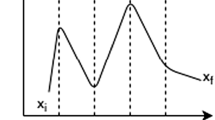Abstract
Path integrals calculate probabilities by summing over classical configurations of variables such as fields, assigning each configuration a phase equal to the action of that configuration. This paper defines a universal path integral, which sums over all computable structures. This path integral contains as sub-integrals all possible computable path integrals, including those of field theory, the standard model of elementary particles, discrete models of quantum gravity, string theory, etc. The universal path integral possesses a well-defined measure that guarantees its finiteness. The probabilities for events corresponding to sub-integrals can be calculated using the method of decoherent histories. The universal path integral supports a quantum theory of the universe in which the world that we see around us arises out of the interference between all computable structures.
Similar content being viewed by others
References
Susskind, L.: The anthropic landscape of string theory. In: Carr, B. (ed.) Universe or multiverse. Cambridge University Press (2007). arXiv:hep-th/0302219
Solomonoff, R.J.: A formal theory of inductive inference part I. Inf. Control 7, 1–22 (1964)
Solomonoff, R.J.: A formal theory of inductive inference part II. Inf. Control 7, 224–254 (1964)
Chaitin, G.J.: Algorithmic Information Theory. Cambridge University Press, Cambridge (1987)
Kolmogorov, A.N.: Three approaches to the quantitative definition of information. Probl. Inf. Transm. 1, 1–7 (1965)
Wilson, K.G.: The renormalization group and critical phenomena. Rev. Mod. Phys. 55, 583–600 (1983)
Rothe, H.J.: Lattice Gauge Theories: An Introduction. World Scientific, Singapore (2005)
Linde, A.: Sinks in the landscape, Boltzmann brains and the cosmological constant problem. J. Cosmol. Astropart. Phys. 22, 1–22 (2007)
Griffiths, R.: Consistent histories and the interpretation of quantum mechanics. J. Stat. Phys. 36, 219–272 (1984)
Omnés, R.: Logical reformulation of quantum mechanics I–III. J. Stat. Phys. 53, 893–932, 933–955, 957–975 (1988)
Omnés, R.: Logical reformulation of quantum mechanics IV. J. Stat. Phys. 57, 359–382 (1989)
Omnés, R.: The Interpretation of Quantum Mechanics. Princeton University Press, Princeton (1994)
Gell-Mann, M., Hartle, J.B.: Classical equations for quantum systems. Phys. Rev. D 47, 3345–3382 (1993). arXiv:gr-qc/9210010
Halliwell, J.J.: Decoherent histories and hydrodynamic equations. Phys. Rev. D 58, 105015 (1998). arXiv:quant-ph/9805062
Halliwell, J.J.: Somewhere in the universe: where is the information stored when histories decohere? Phys. Rev. D 60, 105031 (1999). arXiv:quant-ph/9902008
Halliwell, J.J.: Decoherent histories and the emergent classicality of local densities. Phys. Rev. Lett. 83, 2481–2484 (1999). arXiv:quant-ph/9905094
Halliwell, J.J.: Decoherent histories for spacetime domains. In: Muga, J.G., Sala Mayato, R., Egususquiza, I.L. (eds.) Time in Quantum Mechanics. Springer, Berlin (2001). arXiv:quant-ph/0101099
Hartle, J.B.: Quantum pasts and the utility of history. Phys. Scr. T 76, 67–77 (1998). arXiv:gr-qc/9712001
Dowker, F., Kent, A.: Properties of consistent histories. Phys. Rev. Lett. 75, 3038–3041 (1995)
Nielsen, M.A., Chuang, I.L.: Quantum Computation and Quantum Information. Cambridge University Press, Cambridge (2000)
Lloyd, S.: Universe as quantum computer. Complexity 3(1), 32–35 (1997). arXiv:quant-ph/9912088
Tegmark, M.: Is “the theory of everything” merely the ultimate ensemble theory? Ann. Phys. 270, 1–51 (1998). arXiv:gr-qc/9704009
Schmidhuber, J.: A computer scientist’s view of life, the universe, and everything. In: Freksa, C. (ed.) Foundations of Computer Science: Potential-Theory-Cognition, Lecture Notes in Computer Science, pp. 201–208, Springer (1997). arXiv:quant-ph/9904050
Acknowledgments
This work was supported by the W.M. Keck Center for Extreme Quantum Information Theory (xQIT), DARPA, ARO under a MURI program, NSF, ENI via the MIT Energy Initiative, Lockheed Martin, Intel, Jeffrey Epstein, and by FQXi. The authors would like to thank Janna Levin and Max Tegmark for helpful discussions.
Author information
Authors and Affiliations
Corresponding author
Rights and permissions
About this article
Cite this article
Lloyd, S., Dreyer, O. The universal path integral. Quantum Inf Process 15, 959–967 (2016). https://doi.org/10.1007/s11128-015-1178-7
Received:
Accepted:
Published:
Issue Date:
DOI: https://doi.org/10.1007/s11128-015-1178-7




